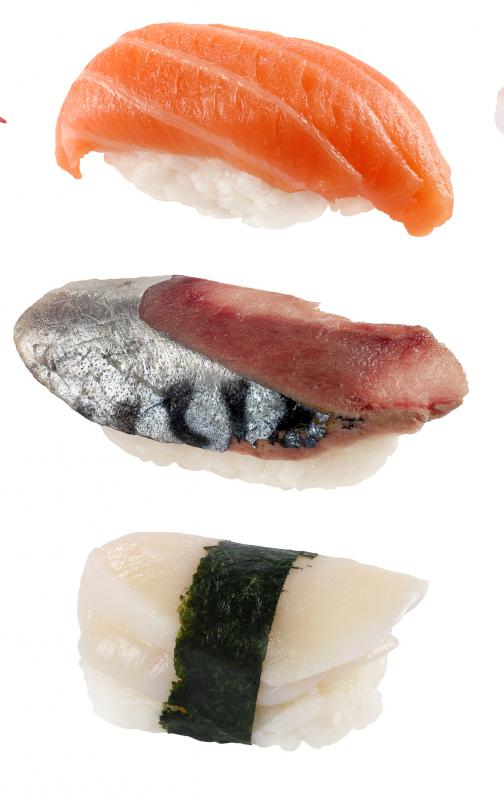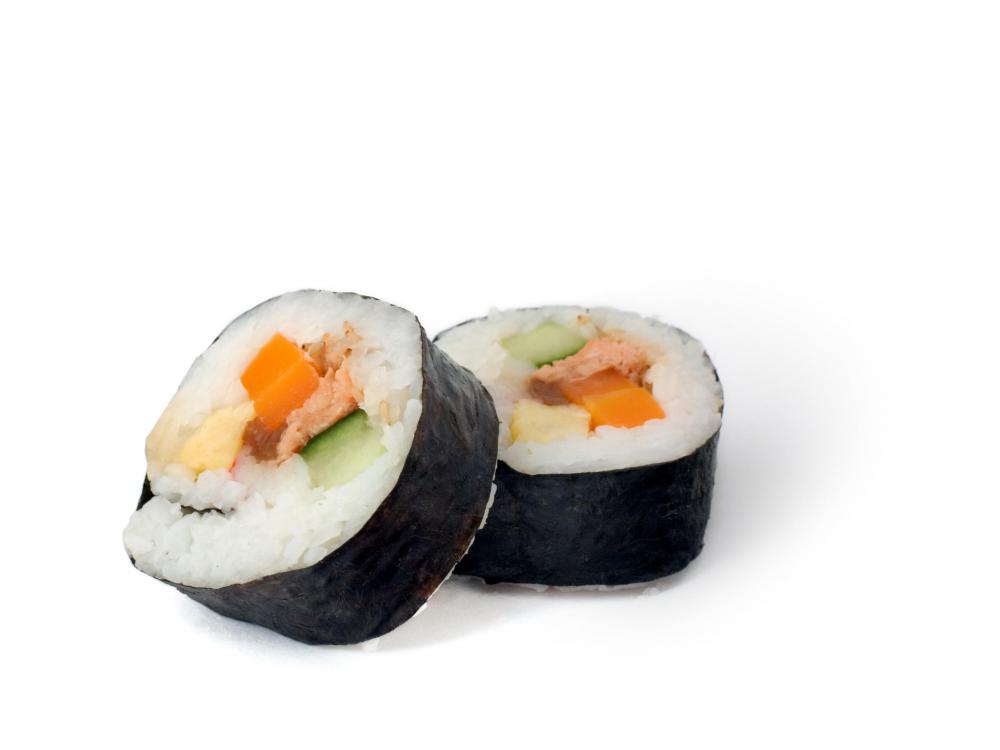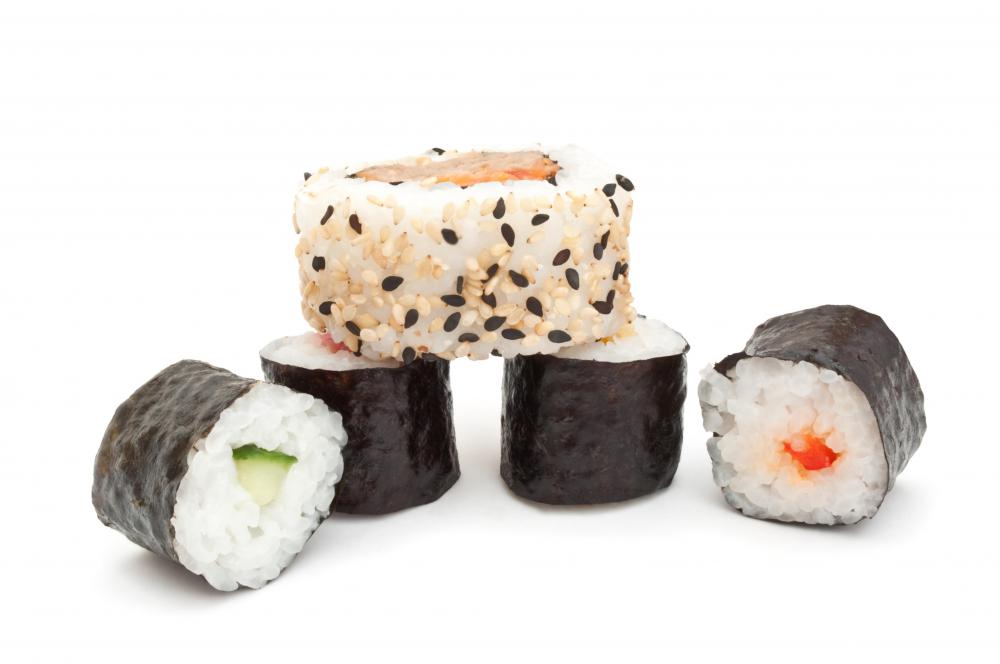At WiseGEEK, we're committed to delivering accurate, trustworthy information. Our expert-authored content is rigorously fact-checked and sourced from credible authorities. Discover how we uphold the highest standards in providing you with reliable knowledge.
What is Special About a Sushi Knife?
When people in the West talk about a sushi knife, they are usually referring to a general sort of cutlery used for everything from slicing vegetables to cutting the final sushi roll. In this context, it's distinguished from Western knives and some other Japanese knives by two main differences: material and sharpening. Sushi knives are usually made of very high quality steel, and are sharpened on one edge only.
Sushi is a Japanese dish made with rice and vegetables or seafood, with egg occasionally added. In the West, the most common type of sushi is makizushi, a type where the filling is usually wrapped in a type of seaweed known as nori, with the rice either on the inside or outside of the wrapper. Sushi often makes use of raw fish, such as snapper or tuna, as a key ingredient.

Traditionally, a sushi knife would be made of an incredibly high-quality carbon steel, the same type used in the forging of katana, traditional Japanese swords. The average knife, sometimes called a bento knife, one would find in a modern kitchen does not use such high-quality materials, instead using top-end stainless steel. The best modern tools still rely on steel with a high carbon content, however.

The other large difference between a sushi knife and the average Western knife is the way in which it is sharpened. While nearly all Western knives are sharpened on both edges of the blade, a professional knife designed for making sushi is sharpened on only one edge, a style known as kataba. For right-handed knives, this is the right edge, and for the rarer knives made for left-handed cooks, the left edge is sharpened instead. Having only one edge of the knife sharpened allows for cleaner cuts and more precision, but learning to use only one edge is more difficult and takes many beginners some time to master.

Looking beyond the general term, there are many different types of knives used in creating sushi. Each is designed in a way that allows it to excel at a specific type of cutting, with some particular fish species having knives designed exclusively to cut them.
The three main sashimi (fish) knives are yanagiba, fuguhiki and takohiki. The yanagi ba looks similar to a Western paring knife, and is used for most fish. The fuguhiki is specifically designed to fillet the puffer fish, or fugu. Yanagiba have longer, thin blades, and are used for octopus or squid. For fish beyond a manageable size, such as large tuna, there are special blades that may be in excess of 6 feet (2 m).

Deba bocho are another type of sushi knife, much wider than yanagiba, and somewhat resembling a Western carving knife. They are used to cut from thicker fish, but their primary purpose is for cutting non-seafood meats such as beef or chicken. This large cleaver is used for the rough cutting of fish, before using yanagiba or another, smaller knife to cut the fish into the thin strips used in sushi.

The unagisaki is designed specifically for filleting eel, a common sushi filling. The knife has a nearly square shape, with a sharp point and right angle at the tip. The point is designed to pierce the eel at the head so that the body may be sliced in one easy motion.
Vegetables are usually cut using one of two types of knife, either the usuba or the nakiri. These knives are straight-edged so that they can slice vegetables easily with one cut, without the need to rock the blade or push it down. The blades are thin, to ensure a clean and precise cut without breaking the vegetables. Nakiri are sharpened on both edges of the blade, making them more suitable for novices, while usuba are sharpened only on one edge.

A simple all-purpose sushi knife may be found relatively inexpensively from many suppliers. Higher-quality and specialty knives may cost significantly more money, and assembling a full kit of knives can be a massive undertaking. For most home users, a knife sold by a trusted cutlery producer will be of suitable quality for everyday use without breaking the bank.
AS FEATURED ON:
AS FEATURED ON:


















Discussion Comments
@ Submariner- Your best bet would be to use one of your friend’s knives in the kitchen before or after a shift. This way you can decide for yourself if you like the balance and feel of the knives.
Once you have tried them, you can shop for them at places like Macy's, Williams Sonoma, or another high-end department store. You probably won't be able to handle these knives at the store without a safety guard on them.
@ Chicada- I have heard about Shun knives. Some of my friends work in kitchens (I wait tables), and they are always arguing about their knives. One says Shun, the other says Global.
I like to cook, but I have never owned a nice knife. Anyway, I was wondering if you know where you can buy a shun sushi knife, or global, or other brands of premium knives for that matter. I would like to be able to talk to someone who knows what knives are best, and actually has a knife I can physically pick up and inspect. Thanks.
I used to cook as a profession, and through the years, I have accumulated a decent knife collection. I don't cook professionally anymore, but I still cook for friends, family, and holidays. Some of my knives are free to be used by the whole family, but I do have my favorites that no one is allowed to touch.
Out of all my knives, my absolute favorites are my Shun Pro knives. The knives are hand constructed of wood and etched steel, and they are insanely sharp. The sushi knife set contains an Usuba, Deba, and Yanagiba knife presented in a bamboo case.
The Ususba looks like a Tanto knife, and is great for chopping vegetables. The Yanagiba is great for delicate cuts, trimming poultry, and filleting fish. The Deba is a great all-around knife, and works well for larger cuts of meats, as well as working with fish. All of the knives are single beveled, and they are easy to sharpen.
Post your comments